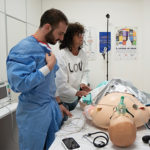According to the U.S. Department of Health and Human Services, the Affordable Care Act (ACA) is about more than just increasing coverage for 20 million-plus uninsured people. The next steps in the health-care-reform process are patient-centered, and will concern when insurance reimbursement will be dependent on patient outcomes and quality of value-based care rather than treatments, procedures, and tests.
Moving forward, doctors and health-care systems will be encouraged to have better coordinated care that focuses on patient wellness and prevention. They’re going to need to improve team collaboration, learn and leverage evolving technology, and adapt quickly to changing reimbursement models. Patient-facing health-care professionals will need to improve their ability to explain complex medical terms, diagnoses, and treatments to patients and their families, so they can do their part in improving their health.
What does that mean for professional medical conferences? If these waves of change haven’t affected your medical meetings’ business model yet, it’s just a matter of time. Here are four issues and recommendations for you to consider as you navigate this changing landscape:
1. Session mix How much of your program should be scientific or clinical versus practice-management or patient-centered? Tip: Have each conference committee member reach out to five to 10 key attendees to understand their priorities. Differentiate needs between those in private practices, those in health-care systems, and academic professionals. Determine which of those segments are most critical to your business model and profession.
2. CME eligibility To attract the right attendees, do all of your sessions need to be accredited? Tip: Focus first on helping your attendees address their pressing priorities, regardless of CME eligibility. CME is being commoditized. High-quality learning is worth their investment of time and money.
3. Submissions or curation? Will your submission process yield the highest-quality sessions, or will you need to invite speakers who you know can address your learning priorities? Tip: Conference organizers are increasingly embracing a combination of curation and submission. Evolve the submission process to better articulate the sessions desired in the call for submissions. Raise your standards and accept fewer submissions. Fill any content holes with curated or invited presenters.
4. Individuals or teams? Is there demand for learning experiences designed not just for physicians but for the care-giving team? Tip: Health care is morphing into a team sport. Teams that learn together thrive together. Instead of segmenting the program by job function, design learning tracks that attract and advance those teams.
The Future of Private Practice
Most health-care professionals are motivated in their careers by saving and improving lives. They make a commitment to lifelong learning to be the best that they can be. Keeping up with the latest in evidence-based diagnosis and treatments is, in itself, a herculean task. In the new world of value-based care and compensation, private practices will have the most difficulty adjusting their business practices to comply and compete. This will cause more private practices to consider partnering or seeking employment with hospital systems. Helping your members navigate their business and succession planning will become a pressing and ongoing need.



